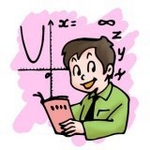
Worksheets and No Prep Teaching Resources
Reading Comprehension Worksheets
History of Mathematics

History of Mathematics
 Worksheets and No Prep Teaching Resources Reading Comprehension Worksheets History of Mathematics |
 History of Mathematics |
| edHelper's suggested reading level: | grades 9 to 12 | |
| Flesch-Kincaid grade level: | 9.89 |
|
The Need for Speed - The Age of Computers
By Colleen Messina |

|
 1 Nothing seemed to satisfy the mathematicians' need for speed in calculations. Pascal's adding machine in 1642 didn't do it; Napier's bones didn't either. Mathematicians were always trying to figure out a way to go faster. Charles Babbage designed a machine to print mathematical calculations quickly, a concept far ahead of most 19th century notions, but that didn't work because the machine couldn't be built. This need for speed led to an ever-expanding series of ideas and inventions that spanned more than a century.
1 Nothing seemed to satisfy the mathematicians' need for speed in calculations. Pascal's adding machine in 1642 didn't do it; Napier's bones didn't either. Mathematicians were always trying to figure out a way to go faster. Charles Babbage designed a machine to print mathematical calculations quickly, a concept far ahead of most 19th century notions, but that didn't work because the machine couldn't be built. This need for speed led to an ever-expanding series of ideas and inventions that spanned more than a century. |
Create Weekly Reading Books
Prepare for an entire week at once! |
| Leave your feedback on The Need for Speed - The Age of Computers (use this link if you found an error in the story) |
 |
History of Mathematics
|
 |
High School Reading Comprehensions and High School Reading Lessons
|
 |
Social Studies
|